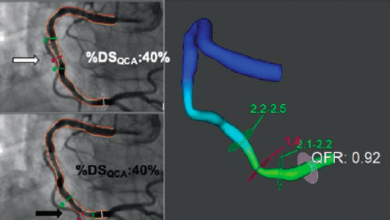Search results
Author(s):
Barbara Stähli
Added:
7 months ago
ESC 2023 — Prof Barbara Stähli (University Hospital Zurich, CH) joins us onsite at ESC 23 to outline the findings of the MULTISTARS AMI Trial (NCT03135275).
MULTISTARS AMI aimed to compare the safety and efficacy of two treatment strategies currently performed in clinical practice, immediate complete revascularization versus staged complete revascularization in patients presenting with ST…
View more
Author(s):
Raffaele De Caterina
,
Carlo De Innocentiis
,
Marco Zimarino
Added:
3 years ago
Multivessel coronary artery disease (MVCAD) is defined by the presence of ≥50% diameter stenosis of two or more epicardial coronary arteries. The presence of MVCAD indicates poorer prognosis and a significantly higher mortality than single-vessel disease. In MVCAD, revascularisation can be achieved by either percutaneous coronary intervention (PCI) or coronary artery bypass grafting (CABG).1,2 A…
View more
Author(s):
Yugo Yamashita
Added:
8 months ago
What's hot at the European Society of Cardiology (ESC) Congress 2023?
Browse our curated coverage of the latest updates in cardiology from Amsterdam.
Watch ourView From the Thoraxcenterseries for a concise line up of the most awaited trials fromProf Nicolas Van MieghemandDr Joost Daemen.
For a deeper dive into key clinical trial data and its applicability, host,Dr Harriette Van…
View more
Author(s):
Robert J Applegate
Added:
3 years ago
Percutaneous Coronary Intervention for ST-elevation Myocardial Infarction
Achieving reperfusion in a timely fashion in patients with ST-elevation myocardial infarction (STEMI) has been established as an effective and life-saving treatment.1–4 This has usually been measured as door-to-balloon time with an established goal of 90 minutes as the time within which reperfusion should be achieved…
View more
Author(s):
Davide Cao
,
Mauro Chiarito
,
Paolo Pagnotta
,
et al
Added:
3 years ago
The prevalence of concomitant coronary artery disease (CAD) in patients with severe aortic stenosis (AS) varies widely among different reports. This depends primarily on the definition used to assess CAD as well as study design and patient selection, therefore making a uniform estimate difficult. Major trials investigating transcatheter aortic valve implantation (TAVI) highlighted a substantial…
View more
Author(s):
Kendra J Grubb
,
Tamim Nazif
,
Mathew R Williams
,
et al
Added:
3 years ago
Concomitant coronary artery disease (CAD) and valvular heart disease is a common problem in the ageing population. It is estimated that the prevalence of mitral regurgitation and aortic stenosis in individuals over the age of 70 is 10 % and 4 %, respectively.1,2 Among patients presenting with symptomatic aortic stenosis, concurrent CAD occurs in over 50 % of those over 70 years of age and over 65…
View more
CAD in Patients Undergoing TAVI
Author(s):
Yinghao Lim
,
Kent Anthony Tan
,
Ivandito Kuntjoro
,
et al
Added:
1 year ago
Article
Author(s):
Matthias Hasun
,
Franz Weidinger
Added:
3 years ago
For ST-segment elevation myocardial infarction (STEMI), there is currently no doubt that primary percutaneous coronary intervention (PPCI) of the infarct related artery (IRA) is the preferred reperfusion strategy.1 In about 50% of cases, STEMI is associated with multivessel coronary artery disease (MVCAD), defined as a ≥50% stenosis in at least one non-infarct related epicardial coronary artery …
View more
Author(s):
Henry Seligman
,
Sayan Sen
,
Sukhjinder Nijjer
,
et al
Added:
3 years ago
International guidelines provide clinicians with evidence-based recommendations on how to manage patients presenting with acute coronary syndromes (ACS). Guidance includes the appropriateness and optimal timing for percutaneous interventions as well as the ideal length of hospital stay.1–5 However, the current global pandemic of coronavirus disease 2019 (COVID-19), has posed an unprecedented…
View more
Author(s):
Luigi Di Serafino
,
Fabio Magliulo
,
Giovanni Esposito
Added:
2 years ago














